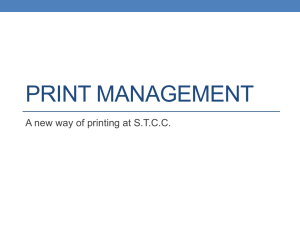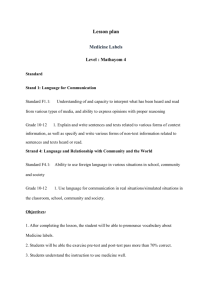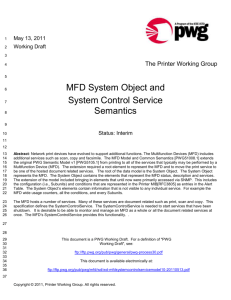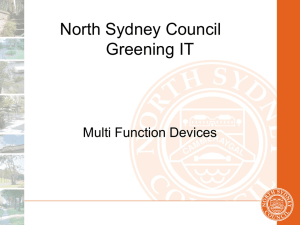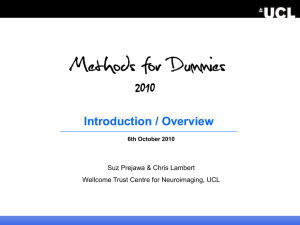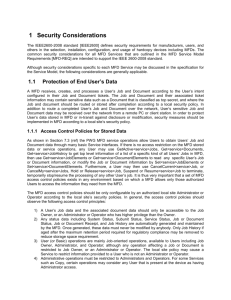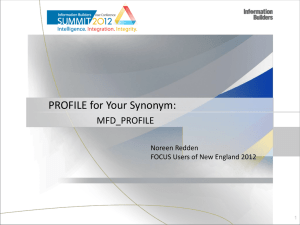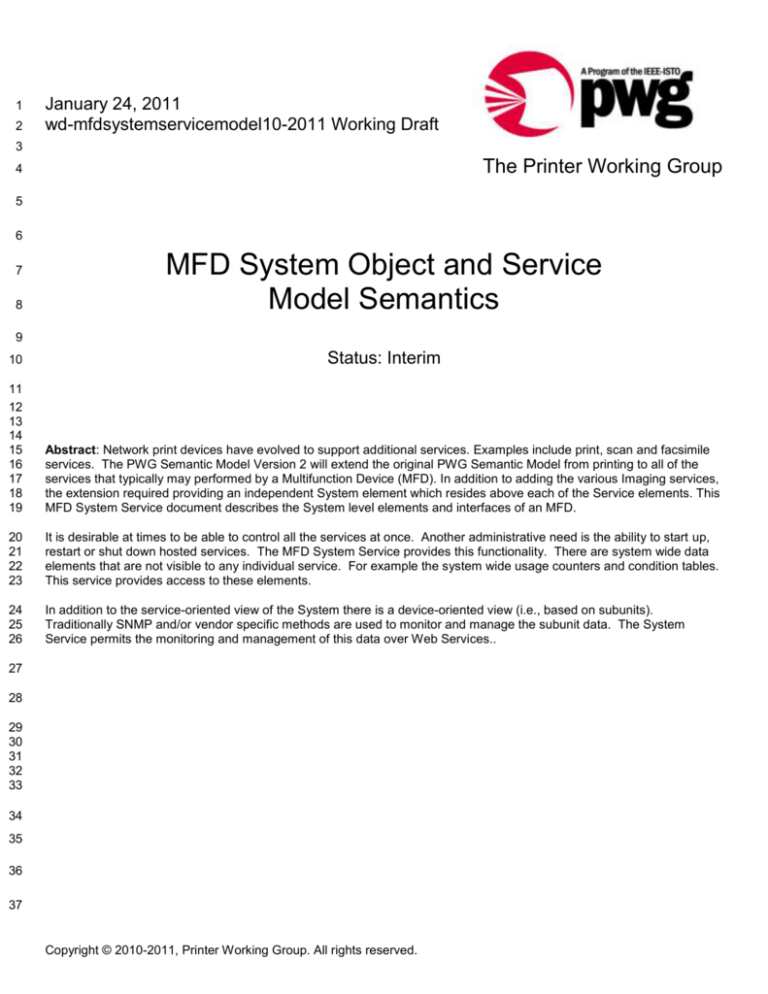
1
2
January 24, 2011
wd-mfdsystemservicemodel10-2011 Working Draft
3
The Printer Working Group
4
5
6
7
8
MFD System Object and Service
Model Semantics
9
10
Status: Interim
11
12
13
14
15
16
17
18
19
Abstract: Network print devices have evolved to support additional services. Examples include print, scan and facsimile
services. The PWG Semantic Model Version 2 will extend the original PWG Semantic Model from printing to all of the
services that typically may performed by a Multifunction Device (MFD). In addition to adding the various Imaging services,
the extension required providing an independent System element which resides above each of the Service elements. This
MFD System Service document describes the System level elements and interfaces of an MFD.
20
21
22
23
It is desirable at times to be able to control all the services at once. Another administrative need is the ability to start up,
restart or shut down hosted services. The MFD System Service provides this functionality. There are system wide data
elements that are not visible to any individual service. For example the system wide usage counters and condition tables.
This service provides access to these elements.
24
25
26
In addition to the service-oriented view of the System there is a device-oriented view (i.e., based on subunits).
Traditionally SNMP and/or vendor specific methods are used to monitor and manage the subunit data. The System
Service permits the monitoring and management of this data over Web Services..
27
28
29
30
31
32
33
34
35
36
37
Copyright © 2010-2011, Printer Working Group. All rights reserved.
MFD: System Object and Service Model Semantics
January 24, 2011
38
39
40
41
Copyright © 2010-2011, Printer Working Group. All rights reserved.
Page 2 of 18
MFD: System Object and Service Model Semantics
January 24, 2011
42
43
44
45
46
47
Copyright (C) 201, The Printer Working Group. All rights reserved.
This document may be copied and furnished to others, and derivative works that comment on, or otherwise explain it or
assist in its implementation may be prepared, copied, published and distributed, in whole or in part, without restriction of
any kind, provided that the above copyright notice, this paragraph and the title of the Document as referenced below are
included on all such copies and derivative works. However, this document itself may not be modified in any way, such as
by removing the copyright notice or references to the Printer Working Group, a program of the IEEE-ISTO.
48
Title: Network MFD System Service Semantic Model and Service Interface
49
50
51
The IEEE-ISTO and the Printer Working Group DISCLAIM ANY AND ALL WARRANTIES, WHETHER EXPRESS OR
IMPLIED INCLUDING (WITHOUT LIMITATION) ANY IMPLIED WARRANTIES OF MERCHANTABILITY OR FITNESS
FOR A PARTICULAR PURPOSE.
52
53
The Printer Working Group, a program of the IEEE-ISTO, reserves the right to make changes to the document without
further notice. The document may be updated, replaced or made obsolete by other documents at any time.
54
55
56
57
The IEEE-ISTO and the Printer Working Group, a program of the IEEE-ISTO take no position regarding the validity or
scope of any intellectual property or other rights that might be claimed to pertain to the implementation or use of the
technology described in this document or the extent to which any license under such rights might or might not be
available; neither does it represent that it has made any effort to identify any such rights.
58
59
60
61
62
63
The IEEE-ISTO and the Printer Working Group, a program of the IEEE-ISTO invite any interested party to bring to its
attention any copyrights, patents, or patent applications, or other proprietary rights, which may cover technology that may
be required to implement the contents of this document. The IEEE-ISTO and its programs shall not be responsible for
identifying patents for which a license may be required by a document and/or IEEE-ISTO Industry Group Standard or for
conducting inquiries into the legal validity or scope of those patents that are brought to its attention. Inquiries may be
submitted to the IEEE-ISTO by e-mail at:
64
info@ieee-isto.org
65
66
67
The Printer Working Group acknowledges that the IEEE-ISTO (acting itself or through its designees) is, and shall at all
times, be the sole entity that may authorize the use of certification marks, trademarks, or other special designations to
indicate compliance with these materials.
68
69
70
Use of this document is wholly voluntary. The existence of this document does not imply that there are no other ways to
produce, test, measure, purchase, market, or provide other goods and services related to its scope.
71
Copyright © 2010-2011, Printer Working Group. All rights reserved.
Page 3 of 18
MFD: System Object and Service Model Semantics
January 24, 2011
72
About the IEEE-ISTO
73
74
75
76
77
78
79
The IEEE-ISTO is a not-for-profit corporation offering industry groups an innovative and flexible operational forum and
support services. The IEEE Industry Standards and Technology Organization member organizations include printer
manufacturers, print server developers, operating system providers, network operating systems providers, network
connectivity vendors, and print management application developers. The IEEE-ISTO provides a forum not only to develop
standards, but also to facilitate activities that support the implementation and acceptance of standards in the marketplace.
The organization is affiliated with the IEEE (http://www.ieee.org/) and the IEEE Standards Association
(http://standards.ieee.org/).
80
81
82
83
For additional information regarding the IEEE-ISTO and its industry programs visit:
http://www.ieee-isto.org.
84
85
86
87
88
89
The Printer Working Group (or PWG) is a Program of the IEEE-ISTO. All references to the PWG in this document
implicitly mean “The Printer Working Group, a Program of the IEEE ISTO.” The PWG is chartered to make printers and
the applications and operating systems supporting them work together better. In order to meet this objective, the PWG will
document the results of their work as open standards that define print related protocols, interfaces, data models,
procedures and conventions. Printer manufacturers and vendors of printer related software would benefit from the
interoperability provided by voluntary conformance to these standards.
90
91
92
In general, a PWG standard is a specification that is stable, well understood, and is technically competent, has multiple,
independent and interoperable implementations with substantial operational experience, and enjoys significant public
support.
93
Contact information:
94
95
96
97
98
99
100
101
102
103
104
105
About the Printer Working Group
The Printer Working Group
c/o The IEEE Industry Standards and Technology Organization
445 Hoes Lane
Piscataway, NJ 08854
USA
MFD Web Page: http://www.pwg.org/mfd
MFD Mailing List: mfd@pwg.org
Instructions for subscribing to the MFD mailing list can be found at the following link:
http://www.pwg.org/mailhelp.html
Members of the PWG and interested parties are encouraged to join the PWG and MFD WG mailing lists in order to
participate in discussions, clarifications and review of the WG product.
106
Copyright © 2010-2011, Printer Working Group. All rights reserved.
Page 4 of 18
MFD: System Object and Service Model Semantics
January 24, 2011
107
Contents
108
1
Introduction ..................................................................................................................................................... 7
109
2
Summary......................................................................................................................................................... 7
110
111
112
3
113
114
115
116
4
117
5
118
119
120
121
122
6
123
124
125
7
126
127
128
129
130
131
8
132
9
PWG and IANA Registration Considerations................................................................................................ 16
133
10
Internalization Considerations ...................................................................................................................... 16
134
135
136
11
137
138
139
12
140
141
13
3.1
3.2
Terminology .................................................................................................................................................... 8
Conformance Terminology .................................................................................................................................... 8
Content Specific Terminology ................................................................................................................................ 8
4.1
4.2
4.3
Rationale ......................................................................................................................................................... 9
Rationale for this SystemService Specification ..................................................................................................... 9
Out of Scope for SystemService............................................................................................................................ 9
Model mapping conventions to XML schema ........................................................................................................ 9
MFD Model Overview ................................................................................................................................... 10
6.1
6.2
6.3
6.4
System Object............................................................................................................................................... 10
SystemCapabilities .............................................................................................................................................. 11
SystemConfiguration ........................................................................................................................................... 11
SystemDescription ............................................................................................................................................... 11
SystemStatus ....................................................................................................................................................... 12
7.1
7.2
System Service ............................................................................................................................................. 14
SystemService Theory of Operation .................................................................................................................... 14
SystemService Interfaces .................................................................................................................................... 14
8.1
8.2
Conformance Requirements ......................................................................................................................... 15
Client Conformance Requirements...................................................................................................................... 15
System Service Conformance Requirements ...................................................................................................... 15
8.2.1
8.2.2
8.3
Objects .......................................................................................................................... 15
Operations ..................................................................................................................... 16
Extensions ........................................................................................................................................................... 16
11.1
11.2
Security Considerations ................................................................................................................................ 17
Protection of Digital Document ............................................................................................................................ 17
Restricted use of System Service Features ........................................................................................................ 17
12.1
12.2
References .................................................................................................................................................... 17
Normative References ......................................................................................................................................... 17
Informative References ........................................................................................................................................ 18
Author’s Address ........................................................................................................................................... 18
142
143
144
Figures
Figure 1 Top Level System View ............................................................................................ Error! Bookmark not defined.
145
Figure 2 SystemCapabilities ................................................................................................................................................. 11
146
Figure 3 SystemConfiguration............................................................................................................................................... 11
147
Figure 4 SystemDescription .................................................................................................... Error! Bookmark not defined.
148
Figure 5 SystemStatus ............................................................................................................ Error! Bookmark not defined.
149
150
Copyright © 2010-2011, Printer Working Group. All rights reserved.
Page 5 of 18
MFD: System Object and Service Model Semantics
151
152
153
January 24, 2011
Tables
Table 1 Mandatory System Operations ................................................................................................................................ 14
Table 2 OptionalSystem Operations ..................................................................................................................................... 15
154
155
Copyright © 2010-2011, Printer Working Group. All rights reserved.
Page 6 of 18
MFD: System Object and Service Model Semantics
January 24,
2011
156
1 Introduction
157
158
159
160
161
162
This document specifies the PWG abstract model for the System Service of a Multifunction Device (MFD).
Included in this document is the content specific terminology, data model, the theory of operation, the
SystemService interfaces and the conformance requirements. The MFD System Service abstract model includes
the functional models and interfaces of the associated System Services for a local network or enterprise-connected
multifunction device.
163
2 Summary
164
165
166
167
168
169
170
171
172
173
174
175
176
177
The MFD service addressed in this specification is the SystemService. The SystemService responds to queries
about its capabilities, configuration, status and descriptive information. The SystemService acts upon requests to
modify system data.
A client application interacting with the SystemService contains a System Client. A System Client interacts with the
End User to obtain the End User’s directives and uses the System Client to communicate with the SystemService
that will execute the directive.
The System scenarios addressed in this specification range from walk-up users that use MFD’s front panel to
initiate requests to remote users that use their computers to initiate requests. The assumption is that it is possible
to implement a Network Connected System Client that is accessible via the device’s front panel. The model also
supports external security services that protects against unauthorized use of the SystemService and access of
System’s data.
Copyright © 2010-2011, Printer Working Group. All rights reserved.
Page 7 of 18
MFD: System Object and Service Model Semantics
January 24,
2011
178
3 Terminology
179
3.1
180
See [MFD] for conformance terminology used. There are no SystemService specific conformance terms.
181
3.2
182
183
184
See [MFD] for common MFD terminology used. For this service the “<service>” in the MFD Terminology section is
replaced with “System”. There is no SystemService specific terminology.
Conformance Terminology
Content Specific Terminology
Copyright © 2010-2011, Printer Working Group. All rights reserved.
Page 8 of 18
MFD: System Object and Service Model Semantics
January 24,
2011
185
4 Rationale
186
4.1
187
188
189
190
191
192
193
In order to support common functionality for managing and monitoring multifunction devices, there is a need to
develop a semantic model and a set of abstract operations and elements for System related services. In order to
implement an abstract model of the operations and elements for the System service, there is need to map them
onto implementable applications and communication protocols that support interactions between System Clients
and SystemService. There is a need to define a binding of the abstract model into Web Service Schema and Web
Service protocol stack.
194
4.2
195
196
197
198
199
200
The basic SystemService model defined in this document is targeted to support enterprise SystemService
applications. However this document does not specify any application specific semantics. The MFD Working
Group charter [CHAR] defines the following as out of scope:
201
4.3
202
203
204
205
206
207
The SystemService model is described in this document as an XML schema. This is for the sake of convenience
and does not require a protocol mapping involving XML. The top level objects such as SystemConfiguration,
Services, and their associated Jobs and Documents can be represented in any number of ways. Abstractly they
are objects which contain attributes or properties that express characteristics of the object. For the remainder of
this document references to attribute or element refer to XML attributes and XML elements respectively. Either of
these can be abstractly considered to be attributes or properties of abstract objects.
Rationale for this SystemService Specification
Out of Scope for SystemService
1. Semantics of any compound service such as Copy-And-Email.
2. Semantics of any workflow protocol, i.e., sequencing and coordination of Jobs across multiple services.
Model mapping conventions to XML schema
Copyright © 2010-2011, Printer Working Group. All rights reserved.
Page 9 of 18
MFD: System Object and Service Model Semantics
January 24,
2011
208
209
5 MFD Model Overview
210
211
212
213
There is both a System Service and a System object in the MFD Model. The distinction between them is that the
System object represents the MFD as a whole and is the root container for all the MFD attributes, components
andservices . The SystemService acts upon the System object on behalf of SystemService clients to query the
state of the System object and to affect the System object state through a well-defined set of operations
214
215
216
217
218
219
The SystemService fits within the MFD model as one of a number of services that can be hosted on a multifunction
device (i.e., System or System object). One difference between the SystemService and other hosted services is
that there is only a single instance. Another difference is that that since this service is not job oriented there are
no jobs coming in or output produced and no subordinate DefaultTicket or Capabilities. Since the SystemService
provides a management interface for the entire system, the mandatory SystemService is always active while the
MFD is available. . (See [MFD])
220
221
222
Below is the top level view of the System schema.
223
224
Figure 1 Top Level System View
225
226
227
6 System Object
228
229
230
231
The System Object elements SystemConfiguration, SystemDescription and SystemStatus are described below.
The Services element contains all the hosted services. See §7 below for the description of the SystemService.
The other services outside the scope of this specification and are covered in their own specification.See
[PWG5106.2-2006] for descriptions of the optional Managers, Agents and Devices elements.
Copyright © 2010-2011, Printer Working Group. All rights reserved.
Page 10 of 18
MFD: System Object and Service Model Semantics
January 24,
2011
232
233
234
235
6.1
SystemConfiguration
236
237
238
239
T The System object has a SystemConfiguration element that contains all the subunits that comprise the MFD.
Note that each service instance contains a service specific view of the subunits used by that service instance. For
example a PrintService would have a Marker subunit but ScanService may not. The MFD Model and Overall
Semantics specification [MFD] defines the system wide Subunits (i.e. SystemConfiguration).
240
241
Figure 2 SystemConfiguration
242
243
244
245
246
247
248
249
250
251
252
253
6.2
SystemDescription
Below is a view of the System’s SystemDescription. SystemDescription provide Descriptive information for the entire
MFD. The element values are administratively set. The element values can be modified directly or modified indirectly
through an operation. The SystemServiceDescription group element includes descriptive information such as system
name and information, and has extension point for vendor specific information. The MFD Model and Common
Semantics specification [MFD] defines the SystemDescription elements.
Copyright © 2010-2011, Printer Working Group. All rights reserved.
Page 11 of 18
MFD: System Object and Service Model Semantics
January 24,
2011
254
255
Figure 3 SystemDescription
256
257
258
6.3
SystemStatus
259
260
261
262
263
264
265
Below is a view of the System’s SystemStatus. SystemStatus provides an optimistic roll up state information for
the hosted services. What is meant by that is if any service is ‘Processing’, the SystemStatus State element will be
‘Processing’. This is the case even if one or more of the services are in the ‘Stopped’ state.
The elements values are maintained by automata and cannot be directly set. The element values can be modified
indirectly through an operation. For example the PauseAllSystemServices operation on the SystemService may
result in the change of the State and StateReasons elements. The MFD Model and Common Semantics
specification [MFD] defines the SystemStatus elements.
Copyright © 2010-2011, Printer Working Group. All rights reserved.
Page 12 of 18
MFD: System Object and Service Model Semantics
January 24,
2011
266
267
268
269
Figure 4 SystemStatus
270
Copyright © 2010-2011, Printer Working Group. All rights reserved.
Page 13 of 18
January 24,
MFD: System Object and Service Model Semantics
2011
271
7 System Service
272
7.1
273
274
The SystemService follows the behaviors and state transitions defined in the MFD Model and Common Semantics
specification [MFD].
275
7.2
276
277
278
279
280
281
282
283
284
285
286
287
288
The SystemService provides a set of service interfaces that is the same for a co-located local System Client or a
Remote System Client via a local interface, a local area network, or the Internet. A user makes a SystemService
request by interacting directly with the SystemService or indirectly through a local System Client via the MFD UI or
a Remote System Client via its software application UI.
SystemService Theory of Operation
SystemService Interfaces
The tables below list the input and output parameters for the defined operations.
fail are expected to return a fault.
Responses to operations that
The semantics for these operations are the same as the operations specified in the MFD Model and Common
Semantics specification [MFD]. The exception is that since the SystemService does not expose a
SystemDocument no operations(e.g., SetSystemDocumentElements) or elements (e.g.,
SystemDocumentProcessing) associated with the document object are applicable to this service. In the tables
below the required parameters are in bold and optional parameters are in normal font.
289
Table 1 Mandatory System Operations
User
Operation Name
DisableAllServices
EnableAllServices
GetSystemElements
ListServices
PauseAllServices
RestartAllServices
RestartService
RestartSystemService
ResumeAllServices
ShutdownAllServices
ShutdownService
StartupAllServices
Input Parameters
ElementsNaturalLanguage, Message,
RequestingUserName
ElementsNaturalLanguage, Message,
RequestingUserName
ElementsNaturalLanguageRequested,
RequestedElements,
RequestingUserName
ElementsNaturalLanguageRequested, ,
RequestingUserName
ElementsNaturalLanguage, Message,
RequestingUserName
ElementsNaturalLanguage,
IsAcceptingJobs, Message,
RequestingUserName,
StartsServicePaused
ElementsNaturalLanguage, Id,
IsAcceptingJobs, Message,
RequestingUserName, ServiceType,
StartServicePaused
ElementsNaturalLanguage, Message,
RequestingUserName
ElementsNaturalLanguage, Message,
RequestingUserName
ElementsNaturalLanguage, Message,
RequestingUserName
ElementsNaturalLanguage, Id, Message,
RequestingUserName ServiceType
ElementsNaturalLanguage,
Copyright © 2010-2011, Printer Working Group. All rights reserved.
Output Parameters
ElementsNaturalLanguage,
System Elements,
ElementsNaturalLanguage,
List of service summary,
Page 14 of 18
MFD: System Object and Service Model Semantics
January 24,
2011
User
Operation Name
StartupService
290
Input Parameters
Output Parameters
IsAcceptingJobs, Message,
RequestingUserName,
StartSystemPaused
ElementsNaturalLanguage, Id,
IsAcceptingJobs, Message,
RequestingUserName ServiceType,
StartServicePaused
Table 2 OptionalSystem Operations
Administrative
Operation Name
DeleteService
SetSystemElements
Input Parameters
Id, ElementsNaturalLanguage, Message,
RequestingUserName, ServiceType
ElementsNaturalLanguage, Message,
RequestingUserName SystemElements
Output Parameters
UnsupportedElements
291
292
293
8 Conformance Requirements
294
295
296
This section describes conformance issues and requirements. This document introduces model entities such as
objects, operations, elements, element syntaxes, and element values. These conformance sections describe the
conformance requirements which apply to these model entities.
297
8.1
298
299
300
301
A conforming client MUST support all REQUIRED operations as defined in this document. For each parameter
included in an operation request, a conforming client MUST supply a value whose type and value syntax conforms
to the requirements of the Model document as specified in Section 7.2. A conforming client MAY supply any
extensions in an operation request, as long as they meet the requirements in Section 8.3.
302
303
When sending a request, a conforming client NEED NOT supply any parameters that are indicated as
OPTIONALLY supplied by the client.
304
305
A client MUST be able to accept any of the elements defined in the model, including their full range that may be
returned to it in a response from a System Service
306
307
308
309
An operation response may contain elements and/or values that the client does not expect. Therefore, a client
implementation MUST gracefully handle such responses and not refuse to inter-operate with a conforming System
Service that is returning extended elements and/or values that conform to Section 8.3. Clients may choose to
ignore any parameters, elements, or values that they do not understand.
310
8.2
311
312
This section specifies the conformance requirements for conforming implementations with respect to objects,
operations, and attributes.
Client Conformance Requirements
System Service Conformance Requirements
313
314
8.2.1 Objects
315
Copyright © 2010-2011, Printer Working Group. All rights reserved.
Page 15 of 18
MFD: System Object and Service Model Semantics
January 24,
2011
316
317
Conforming implementations MUST implement all of the model objects and the mandatory elements they
contain as defined in this specification in the indicated sections:
Section 6 – System Object
318
319
320
321
322
If an object supports an element, it MUST support only those values specified in this document or through the
extension mechanism described in section 8.3It MAY support any non-empty subset of these values. That is, it
MUST support at least one of the specified values and at most all of them.
323
8.2.2 Operations
324
325
Conforming System Service implementations MUST implement all of the REQUIRED SystemService operations,
including REQUIRED requests and responses, as defined in this specification in Table 1:
326
327
328
329
Conforming System Service MUST support all REQUIRED operation elements and all values of such elements if
so indicated in the description. Conforming System Service MUST ignore all unsupported or unknown operation
elements received in a request.
330
8.3
331
332
333
334
335
Conforming System Service MAY support extensions. To extend the model the extensions MUST be fully qualified.
The qualified name MUST NOT be in the PWG target namespace. When extending the model with new elements
the new elements MUST be added at the extension points at the end of the associated sequence of elements.
Extended values for elements MUST conform to the extension patterns defined in the element schema.
Implementers are free to add vendor specific operations to the service.
336
9 PWG and IANA Registration Considerations
337
342
10 This specification and the associated schema will require an update to
register extensions to the MFD Service model. Vendors may use
extensions in their own namespace until such time as an update to the
specification is under review. At that time the extension can be
registered with the PWG and included in the PWG standardInternalization
Considerations
343
344
345
346
347
348
349
350
351
352
353
All Element values defined by enumeration (e.g., State) represent keywords. Keywords are never localized by the
device. The client may convert the values into a form acceptable to the client. This includes not only localization but
also transformations into graphical representation. The Elements with an extensible list of keyword are represented
by the union of an enumeration of keywords and a pattern for new values.
Some of the Elements have values that are Service-generated strings (e.g., State Messages). In each operation
request, the client identifies a natural language that affects the Service generated strings returned by the Service in
operation responses. The Service MUST provide the localized value as requested by the user for any supported
natural languages. A request for a language not supported results in a response with the string in the default
localization.
The final category of string values are those supplied by administrator or End User (e.g., JobName). No localization
is performed on these strings and they are returned in operation responses as set by the administrator or End User.
338
339
340
341
Extensions
Copyright © 2010-2011, Printer Working Group. All rights reserved.
Page 16 of 18
MFD: System Object and Service Model Semantics
January 24,
2011
354
11 Security Considerations
355
356
357
358
359
360
The IEEE 2600-2008 standard [IEEE2600] defines security requirements for manufacturers, administrators, and
others in the selection, installation, configuration, and usage of hardcopy devices including MFDs. The common
security considerations for all MFD Imaging Services that are outlined in the MFD Service Model Requirements
[MFD-REQ] are intended to support the IEEE 2600-2008 standard.
Security considerations specific to each MFD Service are discussed in the specification for the Service Model.
361
362
12 References
363
12.1 Normative References
364
365
366
[MFD]
367
368
369
[PWG5105.1]
370
371
372
PWG 5108.1-2010 MFD Model and Common Semantics version 1, February 20, 2010, W. Wagner,
ftp://ftp.pwg.org/pub/pwg/candidates/cs-sm20-mfd10-20100210-5108.01.pdf
PWG 5105.1-2004 Printer Working Group (PWG) Semantic Model version 1, January 20, 2004, P. Zehler,
T.Hastings, S. Albright, ftp://ftp.pwg.org/pub/pwg/candidates/cs-sm10-20040120-5105.1.pdf
[PWG5108.2]
PWG 5108.2-2009 Network Scan Service Semantic Model and Service Interface version 1, April 10, 2009,
N. Chen, P. Zehler, ftp://ftp.pwg.org/pub/pwg/candidates/cs-sm20-scan10-20090410-5108.02.pdf
373
374
375
[PWG5101.1]
376
377
378
[PWG5100.3]
PWG 5100.3-2001, "Internet Printing Protocol (IPP): Production Printing Attributes - Set1", February 12,
2001, K. Ocke, T. Hastings, ftp://ftp.pwg.org/pub/pwg/candidates/cs-ippprodprint10-20010212-5100.3.pdf
379
380
381
382
[PWG5106.1-2007]
PWG 5101.1-2002 Media Standardized Names, February 26, 2002
ftp://ftp.pwg.org/pub/pwg/candidates/cs-pwgmsn10-20020226-5101.1.pdf
PWG 5106.1-2007, "The Printer Working Group (PWG) Standardized Imaging System Counters 1.1", April
27, 2007, H. Lewis, I. McDonald, J. Thrasher, W. Wagner, and P. Zehler,
ftp://ftp.pwg.org/pub/pwg/candidates/cs-wimscount11-20070427-5106.1.pdf
383
384
385
386
[PWG5106.2-2006]
387
388
[RFC2119]
S. Bradner, “Key words for use in RFCs to Indicate Requirement Levels”, RFC 2119, March 1997.
389
390
391
[RFC2911]
392
393
[RFC 3805]
R. Bergman, H. Lewis, I. McDonald, “Printer MIB v2”, RFC 3805, June 2004.
PWG 5106.2-2006, "The Printer Working Group (PWG) Web-based Imaging Management Service v1.0",
April 21, 2006, L Farrell, R. Landau, H. Lewis, I. McDonald, J. Thrasher, W. Wagner, and P. Zehler,
ftp://ftp.pwg.org/pub/pwg/candidates/cs-wims10-20060421-5106.2.pdf
RFC 2911 “Internet Printing Protocol/1.1 Model and Semantics”, September 2000, T. Hastings, R. Herriot,
R. deBry, S. Isaacson, P. Powell, ftp://ftp.rfc-editor.org/in-notes/rfc2911.txt
Copyright © 2010-2011, Printer Working Group. All rights reserved.
Page 17 of 18
MFD: System Object and Service Model Semantics
January 24,
2011
394
395
396
[rfc3066]
397
398
399
[RFC4395]
400
401
402
RFC 3066 “Tags for the Identification of Languages”, January 2001, H. Alvestrand,
http://www.ietf.org/rfc/rfc3066.txt
RFC 4395 “Guidelines and Registration Procedures for New URI Schemes”, February 2006, T. Hansen, T.
Hardie, L. Masinter, http://www.rfc-editor.org/rfc/rfc4395.txt
[WS-SCAN]
“SystemService DefinitionVersion 1.0 For Web Services on Devices”, November 2006, Microsoft, M
Fenelon, http://www.microsoft.com/whdc/connect/rally/wsdspecs.mspx
403
404
405
[CHAR]
P. Zehler, and I. McDonald, “Charter of the PWG Multifunction Device (MFD) Working Group (WG)”, May 4,
2007, ftp://ftp.pwg.org/pub/pwg/mfd/charter/ch-mfd-20070504.pdf
406
407
408
409
[PWG 5100.11-2010]
PWG 5100.11-2010, Internet Printing Protocol (IPP): Job and Printer Extensions – Set 2 (JPS2), T. Hastings,
and D. Fullman, October 30, 2010, ftp://ftp.pwg.org/pub/pwg/candidates/cs-ippjobprinterext1020101030-5100.11.pdf
410
411
12.2 Informative References
412
413
414
415
416
417
418
419
420
421
422
423
424
425
426
427
428
429
430
431
432
13 Author’s Address
Peter Zehler
Xerox Research Center Webster
Email: Peter.Zehler@Xerox.com
Voice: (585) 265-8755
Fax: (585) 265-7441
US Mail: Peter Zehler
Xerox Corp.
800 Phillips Rd.
M/S 128-25E
Webster NY, 14580-9701
William Wagner
TIC
Email: wamwagner@comcast.net
Additional contributors: (Still to be updated)
Copyright © 2010-2011, Printer Working Group. All rights reserved.
Page 18 of 18

